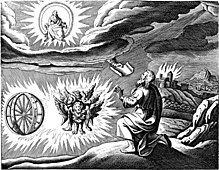
Back المركبة (قبالة) Arabic Misticisme de la carrossa celestial Catalan Merkaba German Merkabah mysticism English Misticismo del carro celestial Spanish عرفان مرکابا Persian Merkabah French מעשה מרכבה HE Merkavah Italian メルカバー Japanese

Mistisisme Merkabah/Merkavah (atau mistisisme kereta perang) adalah sebuah aliran mistisisme Yahudi awal, dari sekitar 100 SM sampai 1000 M, yang terpusat pada penglihatan-penglihatan seperti cerita yang ditemukan dalam Kitab Yehezkiel pasal 1, atau dalam sastra hekhalot ("istana-istana"), mengenai kisah kenaikan ke istana-istana surgawi dan Tahta Allah. Korpus utama dari sastra Merkabah dikomposisikan pada 200-700 M, meskipun rujukan-rujukan terhadap tradisi kereta perang pada masa berikutnya juga ditemukan dalam sastra Chassidei Ashkenaz pada Abad Pertengahan.[1] Teks utama dalam tradisi tersebut adalah Maaseh Merkabah (Karya-karya Kereta Perang).[2]
- ^ From Apocalypticism to Merkabah Mysticism: Studies in the Slavonic ... – Page 224, Andrei A. Orlov (2007). "However, as Gruenwald notes, the main corpus of the Merkabah literature was composed in Israel in the period 200–700CE. Some references to this tradition can be found also in the literature of German Hasidim (twelfth to thirteenth "
- ^ Neusner on Judaism: Literature – Page 74, Jacob Neusner (2005). "When Eleazar finished the Works of the Chariot, Yohanan stood and kissed him on his head and said, Blessed is the Lord, God of Abraham. Jacob who gave to Abraham a son wise and knowing how to expound the glory of our father in heaven."